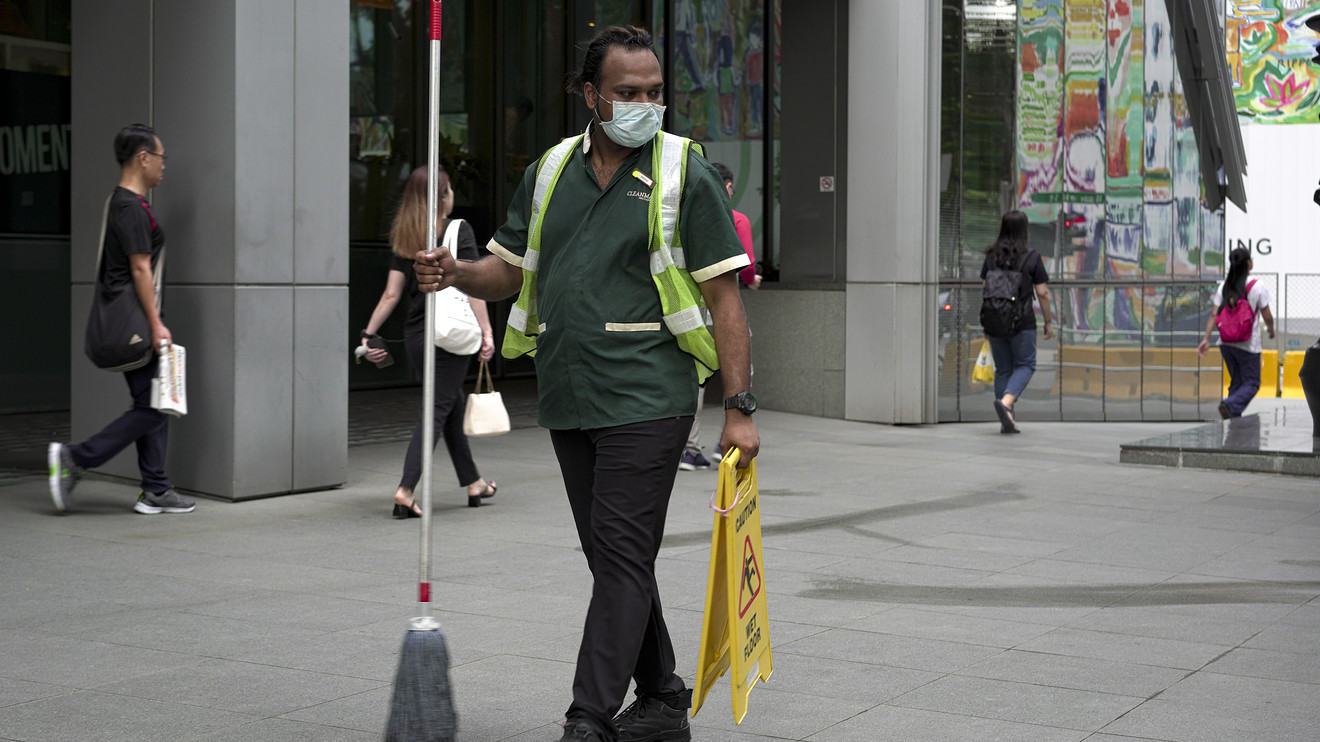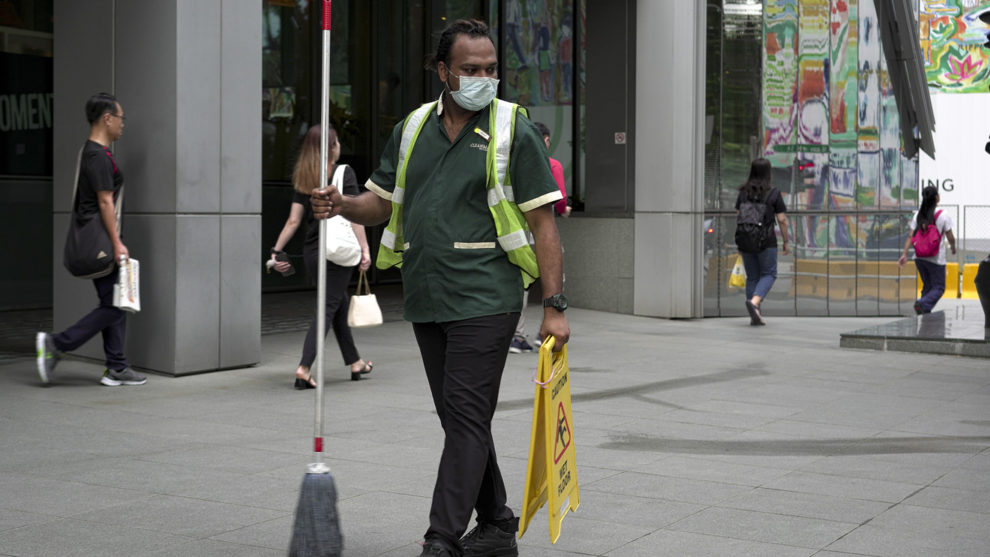
SINGAPORE — This wealthy Southeast Asian city-state is trying to flatten the curve of new coronavirus infections, for the second time.
As recently as late March, Singapore was lauded as a success story in the battle against the coronavirus. Two months after recording its first COVID-19 infection on Jan. 23, Singapore registered just 509 cases and two deaths. It had done so without instituting a lockdown, drawing praise from the World Health Organization for an approach based on targeted isolation orders and moderate social distancing.
But the outbreak has significantly worsened: With 14 deaths and nearly 15,000 cases as of Tuesday, the nation of 5.7 million has the highest recorded infection rate in Southeast Asia, according to the Center for Strategic and International Studies, a Washington, D.C.-based think tank.
Authorities instituted a month-long partial lockdown on April 7 that was subsequently intensified and extended until June, and the famously foreigner-friendly country has banned most visitors since late March. Changi, Singapore’s usually buzzing airport, is eerily quiet, and Singapore Airlines SINGF, +2.13%, regarded by many here as a national treasure, has cut capacity by 96%.
“ These predominantly male laborers tend to live in cramped dormitories on the city’s outskirts, far from the gleaming office and condo towers they helped build. ”
The surge of so-called “second-wave” cases began in the latter half of March, when the government advised the country’s diaspora — a significant portion of whom live in pandemic epicenters like London and New York — to consider returning. But imported case numbers have since fallen sharply. Instead, infections among Singapore’s roughly 300,000 migrant laborers — many of whom are South Asian and work in construction for less than $800 a month — have exploded. They now make up more than 80% of recorded cases.
These predominantly male laborers tend to live in cramped dormitories on the city’s outskirts, far from the gleaming office and condo towers they helped build. It is not unusual, according to migrant advocates and video footage, for workers to be housed a dozen to a room, rendering social distancing all but impossible.
“Migrant populations in Singapore that live in dormitories are somewhat invisible and perhaps forgotten,” said Richard Coker, the former head of the infectious-disease program at the National University of Singapore’s Saw Swee Hock School of Public Health. “COVID-19 highlights those that are the most invisible.”
Foreign workers also had challenges accessing health care, said Catherine James, the executive director of the Humanitarian Organization for Migration Economics (HOME), a Singapore-based nonprofit. For instance, a 39-year-old Bangladeshi citizen who was among the first infected migrant workers visited three health-care providers. He was repeatedly sent back to his lodgings before being admitted to a hospital and spending two months in an intensive-care unit.
“ Singapore converted over two dozen worker dormitories into isolation areas; workers cannot leave their residences for 14 days. Many have been shifted to military camps and floating hotels. ”
“In the normal course of events, they will think and rethink before saying they are unwell [because] there’s a chance their work permit will get canceled if they don’t work for a few days,” James said, adding that HOME has warned since the 2016 Zika virus outbreak that “putting workers in cramped locations make them more vulnerable.”
Josephine Teo, Singapore’s labor minister, has said that dormitory operators have a responsibility to “ensure modern sanitation and no overcrowding,” and that they were reminded in January to improve hygiene standards. And to be sure, Singapore has ramped up migrant-support efforts since the coronavirus outbreak intensified. It converted more than two dozen worker dormitories into isolation areas, where workers cannot leave their residences for 14 days — though there is now less crowding, as many have been shifted to military camps and floating hotels.
The government has also assured workers that they would continue to be paid through their quarantine and would be provided with food and access to internet and remittance services. Infected laborers also receive free health care.
“We will care for Indian migrant workers here, just as we care for Singaporeans,” Prime Minister Lee Hsien Loong told his Indian counterpart, Narendra Modi, during a call last week. “They have made many contributions to Singapore, so we have a responsibility for them.”
“ One dormitory operator, which is currently under investigation, allegedly locked 20 laborers into a room until law enforcement intervened. ”
Nonetheless, there have been severe lapses. Some workers have noted continued difficulty with social distancing and a lack of hand soap in bathrooms, according to the Washington Post and the Guardian. One dormitory operator, which is currently under investigation, allegedly locked 20 laborers into a room until law enforcement intervened.
While many Singapore residents and companies have pledged donations, “the fact that NGOs are out and about distributing food when that is the responsibility of employers is evidence that employers have not fulfilled their obligations,” James said.
However, no foreign laborers have died as a direct result of COVID-19, according to official reports, and daily infections outside the migrant-worker community have recently hovered in the low double digits.
The partial lockdown has also bought time for Singapore to build new isolation facilities — including one with robots that serve food — and nearly triple its testing capacity to more than 8,000 daily. The health-care system hasn’t had to be tested as it was in Wuhan, northern Italy or New York City.
“Our collective efforts are achieving results,” Lawrence Wong, a government minister leading anti-coronavirus efforts, wrote in a recent Facebook FB, -2.44% post. “But we must now give a further push to bring down the numbers more sharply.”
“ ‘There’s no turning back on cramped dorms because there’s been enough attention to jolt people up. It’s time for a policy rethink based on empathy.’ ”
Coker, now an emeritus professor of public health at the London School of Hygiene & Tropical Medicine, said that “in some sense, it is fortunate that Singapore was the country in the region that reported this surge, because it has the resources to deal with it.”
“It’s got such a good [disease] surveillance system and a good health-care system,” he said.
James, meanwhile, said she hopes that the spotlight on migrant labor will herald reforms in health-care access and employment laws. “The good part of the crisis is that it has catalyzed new ways of thinking. There’s no turning back on cramped dorms because there’s been enough attention to jolt people up,” she said. “It’s time for a policy rethink based on empathy.”
The International Monetary Fund predicts that Singapore’s economy will contract by 3.5% this year before recovering in 2021 — but how and when the equatorial nation will return to the neighborhood of normal remains an open question.
Singapore, a U.S. ally with close cultural and economic ties to China, was already reeling from the effects of the Sino-American trade war. And Maybank Kim Eng, a regional financial institution, forecasts that the additional four-week lockdown could cost the country about $7 billion in lost economic activity.
Policy makers have said it is possible that some measures will be tightened even as others are loosened, and Coker thinks they will be carefully observing how South Korea and major cities in the U.S. and China have reduced their virus reproduction rate. Meanwhile, Singapore’s sizable financial industry means that it’s better placed than tourism-dependent neighbors like Thailand, which require workers to be physically present.
“The longer this goes on, the more people’s behavior changes and we get used to it,” he said. “I don’t think we will ever return to ‘normal.’”











Add Comment